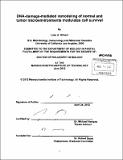DNA-damage-mediated remodeling of normal and tumor microenvironments modulates cell survival
Author(s)
Gilbert, Luke A. (Luke Andrew)
DownloadFull printable version (17.68Mb)
Alternative title
DNA damage mediated remodeling of tumor and normal microenvironments modulates cell death
Other Contributors
Massachusetts Institute of Technology. Dept. of Biology.
Advisor
Michael Hemann.
Terms of use
Metadata
Show full item recordAbstract
Chemotherapeutic regimens involve the systemic administration of genotoxic compounds that induce cancer cell death via well-established DNA damage response signaling networks. While modern chemotherapeutic regimens can be curative, chemotherapeutic drug resistance remains a major clinical problem. This drug resistance can be cancer cell intrinsic or extrinsic. Mechanisms of cancer cell intrinsic drug resistance include apoptotic defects, DNA repair mechanisms, drug efflux pumps, and cell cycle defects. Less well understood is how cancer cell extrinsic drug resistance occurs and whether this process is modulated by DNA damage associated with chemotherapy. Here, I have used the E[mu]-myc lymphoma model to study cancer cell extrinsic drug resistance. In this model, I see that certain tumor microenvironments such as the thymus are chemoresistant and that DNA damage in thymic endothelial cells induces an acute secretory response that promotes lymphoma cell chemotherapeutic resistance. Mechanistically, DNA damage induces the rapid activation of a p38-dependent stress response in endothelial cells resulting in the acute release of many proteins including IL-6 and Timp-1. Together these two proteins promote lymphoma cell resistance to apoptosis through the induction of Bcl-XL. While this acute secretory response includes some of the same secreted proteins as the senescenceassociated secretory phenotype it differs substantially in both kinetics and mechanism suggesting the two are distinct cellular processes. Furthermore, we see in these chemoresistant microenvironments that drug response requires activation of death-receptor-activated apoptosis suggesting an unexpected complexity to therapeutic response in drug-resistant tumor microenvironments. Thus, local pro-survival signaling may present a fundamental barrier to tumor clearance by genotoxic agents, suggesting that effective treatments need to target both cancer cells and the tumor microenvironment. Long-lived metazoans have evolved complex mechanisms of tissue protection and repair. To better understand the physiological importance of secretory phenotypes in response to sterile injuries such as DNA damage, we investigated whether IL-6 promotes progenitor cell survival and tissue repair. Here, I have identified a role for the acute DNA-damage-mediated secretory phenotype in the protection of hematopoietic stem cells and in thymic regeneration. Together these observations suggest that tissue repair and response to chemotherapy can be similar processes with different therapeutic windows.
Description
Thesis (Ph. D.)--Massachusetts Institute of Technology, Dept. of Biology, 2012. Cataloged from PDF version of thesis. Includes bibliographical references (p. 176-196).
Date issued
2012Department
Massachusetts Institute of Technology. Department of BiologyPublisher
Massachusetts Institute of Technology
Keywords
Biology.